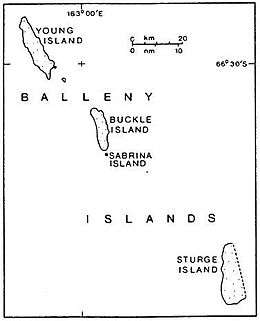Young Island
 Young Island is the northernmost of the Balleny Islands | |
 Young Island Location in Antarctica | |
| Geography | |
|---|---|
| Location | Antarctica |
| Coordinates | 66°17′S 162°25′E / 66.283°S 162.417°ECoordinates: 66°17′S 162°25′E / 66.283°S 162.417°E |
| Archipelago | Balleny Islands |
| Length | 35 km (21.7 mi) |
| Width | 7 km (4.3 mi) |
| Highest elevation | 1,340 m (4,400 ft) |
| Administration | |
|
None | |
| Demographics | |
| Population | Uninhabited |
| Additional information | |
| Administered under the Antarctic Treaty System | |
| Young Island | |
|---|---|
| . | |
| Elevation: | 1,340 m (4,400 ft) |
| Coordinates: | 66°25′S 162°27′E / 66.42°S 162.45°E |
| Location: | Subantarctic island |
| Type: | Stratovolcano |
| Last eruption: | Unknown |
| First ascent: | Unknown |
| Easiest route: | Unknown |
Young Island (66°17′S 162°25′E / 66.283°S 162.417°E) is the northernmost and westernmost of the three main islands in the uninhabited Balleny Islands group located in the Southern Ocean. It lies 8 kilometres (5.0 mi) northwest of Buckle Island, some 115 kilometres (71 mi) north-northeast of Belousov Point on the Antarctic mainland.
The island is roughly semi-oval in shape, with a long straight east coast and a curved west coast meeting at Cape Scoresby in the south and Cape Ellsworth in the north. The distance between these two capes is 19 nautical miles (22 mi), and at its widest the island is 4 nautical miles (4.6 mi) across.[1] The island is volcanic, with active fumaroles, and a height of 1,340 metres (4,400 feet). It is entirely covered with snow. An explosive VEI-7 eruption occurred from Young Island 1,700,000 years ago.[2]
Several small islets lie in the channel separating Cape Scoresby and Buckle Island, the largest of which is Borradaile Island. Several sea stacks lie off the island's northern tip. These are known as the Seal Rocks.
The island forms part of the Ross Dependency, claimed by New Zealand (see Antarctic territorial claims).
See also
References
- LeMasurier, W. E.; Thomson, J. W. (eds.) (1990). Volcanoes of the Antarctic Plate and Southern Oceans. American Geophysical Union. p. 512 pp. ISBN 0-87590-172-7. Cite uses deprecated parameter
|coauthors=(help)